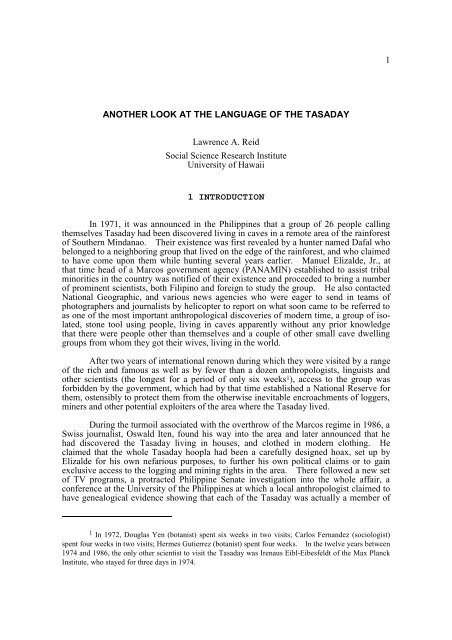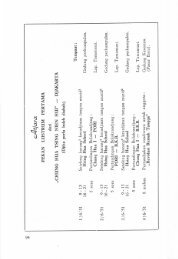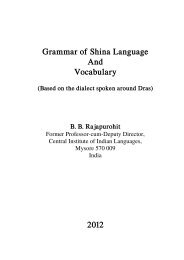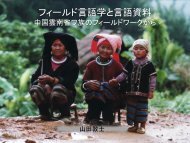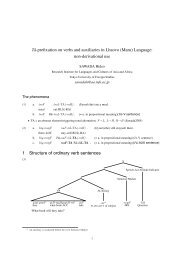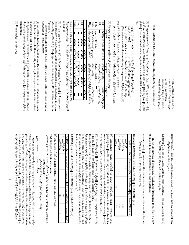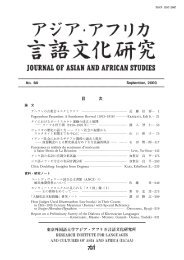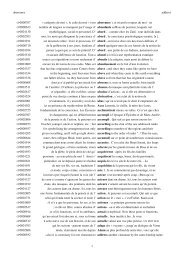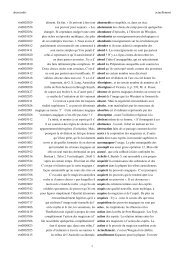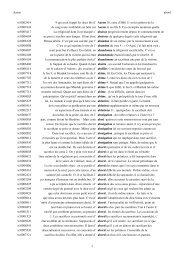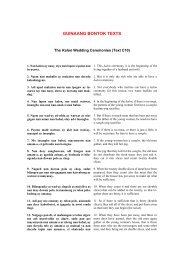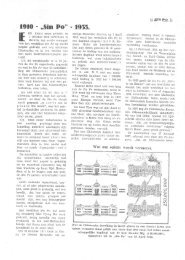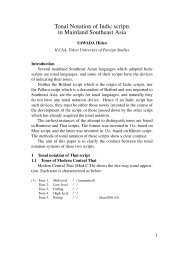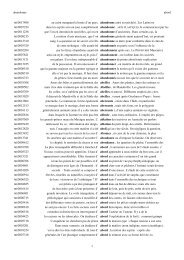1 ANOTHER LOOK AT THE LANGUAGE OF THE TASADAY ...
1 ANOTHER LOOK AT THE LANGUAGE OF THE TASADAY ...
1 ANOTHER LOOK AT THE LANGUAGE OF THE TASADAY ...
You also want an ePaper? Increase the reach of your titles
YUMPU automatically turns print PDFs into web optimized ePapers that Google loves.
1<strong>ANO<strong>THE</strong>R</strong> <strong>LOOK</strong> <strong>AT</strong> <strong>THE</strong> <strong>LANGUAGE</strong> <strong>OF</strong> <strong>THE</strong> <strong>TASADAY</strong>Lawrence A. ReidSocial Science Research InstituteUniversity of Hawaii1 INTRODUCTIONIn 1971, it was announced in the Philippines that a group of 26 people callingthemselves Tasaday had been discovered living in caves in a remote area of the rainforestof Southern Mindanao. Their existence was first revealed by a hunter named Dafal whobelonged to a neighboring group that lived on the edge of the rainforest, and who claimedto have come upon them while hunting several years earlier. Manuel Elizalde, Jr., atthat time head of a Marcos government agency (PANAMIN) established to assist tribalminorities in the country was notified of their existence and proceeded to bring a numberof prominent scientists, both Filipino and foreign to study the group. He also contactedNational Geographic, and various news agencies who were eager to send in teams ofphotographers and journalists by helicopter to report on what soon came to be referred toas one of the most important anthropological discoveries of modern time, a group of isolated,stone tool using people, living in caves apparently without any prior knowledgethat there were people other than themselves and a couple of other small cave dwellinggroups from whom they got their wives, living in the world.After two years of international renown during which they were visited by a rangeof the rich and famous as well as by fewer than a dozen anthropologists, linguists andother scientists (the longest for a period of only six weeks 1 ), access to the group wasforbidden by the government, which had by that time established a National Reserve forthem, ostensibly to protect them from the otherwise inevitable encroachments of loggers,miners and other potential exploiters of the area where the Tasaday lived.During the turmoil associated with the overthrow of the Marcos regime in 1986, aSwiss journalist, Oswald Iten, found his way into the area and later announced that hehad discovered the Tasaday living in houses, and clothed in modern clothing. Heclaimed that the whole Tasaday hoopla had been a carefully designed hoax, set up byElizalde for his own nefarious purposes, to further his own political claims or to gainexclusive access to the logging and mining rights in the area. There followed a new setof TV programs, a protracted Philippine Senate investigation into the whole affair, aconference at the University of the Philippines at which a local anthropologist claimed tohave genealogical evidence showing that each of the Tasaday was actually a member of1 In 1972, Douglas Yen (botanist) spent six weeks in two visits; Carlos Fernandez (sociologist)spent four weeks in two visits; Hermes Gutierrez (botanist) spent four weeks. In the twelve years between1974 and 1986, the only other scientist to visit the Tasaday was Irenaus Eibl-Eibesfeldt of the Max PlanckInstitute, who stayed for three days in 1974.
L.A. Reid--The Tasaday Language 2one of the two neighboring language groups, either Blit Manobo or Tboli, and were paidactors in an elaborate scheme to defraud the general public. The Tasaday were beingcalled the greatest hoax since Piltdown man.I first became aware of the issues during a dinner at The International Congresson Anthropological and Ethnological Sciences in Zagreb, in 1988, when I found myselfseated next to Judith Moses, the producer of the ABC-TV documentary, "The Tribe ThatNever Was." By the following day I had also had conversations with John Nance,author of the book "The Gentle Tasaday". He had been in the Philippines in 1971 whenthe story of the Tasaday was first announced and had managed to get invited aboard thehelicopters whenever they flew visitors in to visit the group, and was absolutelyconvinced as to their authenticity.I had gone to the Congress to present a paper on my research on PhilippineNegrito groups, but decided to also sit in on the symposium that was being held on theso-called Tasaday Hoax. It seemed to me that there was one line of evidence that hadnot been explored. If a hoax was involved, surely it would be apparent in the linguisticdata that was gathered by the linguists and anthropologists during the initial contacts thathad been made with them in the early '70s. Tboli is not a Manobo language, in fact it isas different from Manobo languages as perhaps English is from Russian. They belongto different first order subgroups of Philippine languages. It would be interesting, Ithought, to critically examine the responses that were recorded to questions posed by thefirst investigators, for signs of linguistic hanky-panky, or at least for evidence that therewas an educated Tboli masquerading as a primitive stone-age cave-dweller.The result of this examination of the data was that I became pretty muchconvinced that the hoax proponents were themselves the hoax makers. There seemed tome to be no evidence whatsoever that there had been any linguistic shenanigans going on.In fact, the types of responses given and the differences apparent in the lists of differentinvestigators, seemed to me to be clear evidence of the linguistically unsophisticatednature of the Tasaday. I presented the results of this study in 1989, at an AmericanAnthropological Association symposium in Washington, D.C., which had been called toevaluate the scientific evidence for and against the Tasaday. It was published last yearin "The Tasaday Controversy: Assessing the Evidence," AAA Scholarly Series SpecialPublication No, 28, edited by Thomas N. Headland. Included in the book are threeother papers dealing with the Tasaday language. One was by Carol Molony, asociolinguist who spent a total of two weeks with the Tasaday in 1972 during which shegathered about 800 words and 45 pages of text which she subsequently published.Another was by Richard Elkins, an SIL linguist who got his Ph.D. from UH in 1964, andwho by 1971 had spent 18 years doing linguistic work in the Philippines, mostly with theCentral Bukidnon Manobos, whose language he spoke fluently. He spent only 4 dayswith the Tasaday in 1971 because of health problems that forced him to leave earlier thanplanned. He did however collect a list of about 350 items. The third paper was byanother SIL linguist, Clay Johnston, who had spent 10 years with the Manobo group wholive in the town of Kalamansig, north of the Tasaday area, and who spoke theKalamansig Manobo language fluently. He had been asked to review the Tasaday datathat had been collected in the early '70s and to compare it with the language that he knew.Molony's paper (1992:115) concluded that "logically, it is very difficult toimagine that Elizalde or anyone else was clever enough" to create a language andchoreograph events for over a year and a half so that neither adults nor children ever
SEALSIII Conference Keynote Address 3slipped in their presentation to outsiders. She claimed that the speech of the Tasadaywas a distinct dialect of Manobo indicating separation from other groups, though notnecessarily complete isolation from them, as she had earlier claimed.Elkins' paper (1992:117) similarly concluded that "the Tasaday, at the time oftheir discovery, were a speech community which had developed, to some degree,separately from the other Manobo groups nearby". He also noted that other aspects ofTasaday social behavior were atypical of other Mindanao tribal groups with which hewas familiar, including the Cotabato Manobo, and that it followed that "the Tasaday werenot picked at random from other groups and persuaded to perform for journalists andsocial scientists."Johnston checked both Elkins and Molony's data against his own knowledge ofthe nearby Cotabato Manobo language, and played a taped text which had been recordedby Molony, to native speakers of that language. His conclusion was that Tasaday was aclose dialect of the language that he knew, with perhaps as much as 90% sharedvocabulary 2 . The tape was recognized by native speakers as being a variety of CotabatoManobo, but spoken "with different intonation", "having gaps", or being "clumsy,awkward" (1992:145). He did note also that vocabulary differences between the twodialects were significant, in that many were basic terms such as "sun", "moon", "star","cloud", "rain", "tree", etc., many of which had no known equivalent in any otherPhilippine language, while one term, Tas nahagtay "dead", had completely switched itsmeaning from Kal nahagtagtay "alive".During the discussion period at the end of the presentation of these papers, ahusband and wife team of Filipino linguists, Araceli and Cesar Hidalgo, took the floor tobriefly describe the results of their own research with the Tasaday, a three day venture in1989, during which they were able to collect Tasaday equivalents for a modified Swadesh100 word list. Their conclusions were extraordinary in that they claimed to haveuncovered a large number of previously unrecorded terms within the basic vocabulary listthat were apparently unrelated to other Philippine languages. Their calculations showedthat Tasaday shared only 25% with its closest linguistic neighbor, Cotabato Manobo, andas low as about 9% with Binukid, one of the Northern Manobo languages. Usingglottochronological methodology for estimating the approximate time-depth ofcoonvergence, they then claimed that the Tasaday had begun diverging from otherManobos about 8000 years ago, and completed their separation from Cotabato Manobosome 4,500-5000 years 3 , which would be great if it were true, the Southern Philippineswould be the homeland for Proto-Austronesian, and Tasaday would be a first order2 This was perhaps an unwise extrapolation, given that his count was based on a couple of hundredwords of basic vocabulary, where cognature could be expected to be higher than in other areas ofvocabulary. Nevertheless the dialects were similar enough it seems that the Tasaday text was quiteintelligible to Southern Cotabato Manobo speakers.3 One of the linguists who had first gotten data from the group in 1971, Teodoro Llamzon, usingglottochronology had estimated a period of separation from Cotabato Manobo as around 800 years, and thisfigure was widely reported as being the period of isolation that this group must have had from otherManobo people.
L.A. Reid--The Tasaday Language 4branch of the Austronesian language family, and one moreover that had developedwithout contact with any other language.Their second claim was even more interesting. They claimed that the texts thatMolony collected in 1972 were grammatically inconsistent.The Hidalgos' concluded that at the time Molony did her field work, the Tasadaywere in the process of becoming bilingual in Blit Manobo the language of thegeographically closest Manobos, and that it was their clumsy attempts at speaking Blitthat Molony recorded. It is interesting in this respect that early Blit Manobo interpretersclaimed to understand less than half of what the Tasaday said, and the journalist JohnNance discusses instances in his book when the Tasaday switched to speaking some formof language that nobody understood, at times when they did not wish anybody to knowwhat they were talking about. The Hidalgos end their paper with a plea to record andstudy the real Tasaday language before it becomes extinct.This was the state of affairs when I went to the Philippines in January, 1990 to dofive months research with several of the Negrito groups of Northern Luzon. In Marchof that year, I had returned to Manila after gathering a set of data from the last remainingspeakers of the Arta language, a group of about 13 Negritos, most of whom wereintermarried with speakers of other languages. In response to their pleas for assistance Icalled the then Under-Secretary for Agriculture in charge of special projects, to see ifsome sort of government aid might be available to the Arta. After discussing myrequest, I was surprised to be asked if I would like to visit the Tasaday. It turned outthat the Under-Secretary for Agriculture was Carlos Fernandez, a sociologist who hadvisited the Tasaday on several occasions in 1971 and subsequently. As I understood it,he had just returned from a visit to Tboli town to investigate reports of loggers attemptingto enter the Tasaday reserve. He told me that a group of Tasaday had temporarily lefttheir homes and were staying in the house of the town mayor, and that it would be anexcellent opportunity for me to get some Tasaday data without the difficulty of hikinginto the rainforest if I could drop what I was doing and immediately go south toMindanao. He said all expenses would be taken care of. A hasty meeting wasarranged with Elizalde, whom I had never met before. A Filipino anthropologist, AmyRogel-Rara, who had spent approximately a year in the area collecting genealogical datain 1988-89 was asked to accompany me, and in three days we were face to face with agroup of Tasaday that included Dul and her husband Udelen, four of their children,Maman, Okon, Klohonon, and Fakel; Lobo and Funding, the second of his three wives;Natek and Dego, sons of Bilangan and Etut; and Adug. Also present at various timesduring the next eight days of my visit were several speakers of Blit Manobo, includingDatu Mafalo, Dudim and his sister Bol, and Igna Kilam, a speaker of Sdaf Manobo, allnames familiar to any who have followed the saga of the Tasaday. There was also aneducated young man who spoke Kalamansig Cotabato Manobo and a considerablenumber of speakers of Tboli, including Mai Tuan, the mayor, and one or another of his13 or so legal wives, and several of his children. My main language assistants were thewoman Dul, and the young man Lobo. I also gathered data from speakers of both Blitand Sdaf, as well as from the speaker of Kalamansig, who requested a copy of myTasaday wordlist, so he could learn to speak the language. He obviously did notunderstand it well enough to be able to communciate easily with them, as would beexpected if Johnston's claims reflected the situation as it was at the time I was there.
SEALSIII Conference Keynote Address 5I worked with a wordlist of over 600 items, not all of which were collected, and Ialso elicited equivalents of a set of sentences chosen to reveal the syntactic patternscommonly found in other Philippine languages. The anthropologist Amy Rogel-Rara,who was well-known to most of the members of the group because of her prior researchin the area, conveyed my questions in Tagalog to Igna, who has acted as an interpreter forvisitors since the earliest contacts with the Tasaday. Igna then conveyed them to Dul,speaking in what was said to be Blit Manobo. By the end of the period I was directlyeliciting from Lobo, using simple Tasaday questions.Because I had not been expecting to make this trip to the Tasaday, I did not haveany of the previous Tasaday data with me, which handicapped me somewhat, but it alsomeant that I was not influenced by the other data sources and I ended up with acompletely independent set of data against which I could compare the previous materials.Knowing the claims that the Hidalgos had made, I made it clear that I wanted to getwords from the real Tasaday language that they used to speak before. The forms that Irecorded seemed to me to confirm that the language is more lexically aberrant than hadbeen claimed by Johnston, but probably not as aberrant as the Hidalgos had claimed. Asound change that had not been noted was found, and at least one other phonologicaldifference from Cotabato Manobo was discovered. Explanations were also available forsome of the so-called syntactic irregularities that the Hidalgos described.I must emphasize that my conclusions must be considered very tentative. I wasnot adequately prepared for the research, the elicitation conditions were far from ideal,with crowded noisy rooms and lots of on-lookers, and a three-way interpretationprocedure for elicitation. Moreover, I only have Johnston's unpublished CotabatoManobo dictionary available for comparative purposes. There is another more extensivedictionary by Errington available in computer printout, but I have not yet been able toacquire a copy of it.2 PHONOLOGYThe Tasaday phonology is very similar to each of the Manobo speech varietiesspoken in Cotabato province. with 6 vowels: i, u, o, «, «, a; and 15 consonants: f, t, k,/, b, d, g, m, n, N, s, h, l, w, y. The mid front vowel is relatively infrequent. It doesnot occur in forms in Tasaday that are unique, and even in forms that appear to becognate with Kal forms having a midfront vowel, Tasaday, and sometimes also Blit andSdaf have a corresponding central vowel. For example: Tsd, Blt, Sdf b«l« «l«N, Kal b«l«n"cheek"; Tsd tuk«/«/«y, Kal tuk«/«y«y "few, small"; Tsd oÛw« w«/; CM ow«/ "term ofaddress for female friend"; Tsd m«t«/«t«/«l "strong", Kal t«/« «/«l "fast".There is a sound change which seems to be in progress in Tasaday, but not in anyof the other surrounding Manobo languages (although it does occur in some Manobolanguages spoken outside Cotabato) by which the phoneme /l/ loses its lateral featureand is pronounced as [y] intervocalically, and as either a vowel, [a] or [«], or sometimes[«l«l] word finally. In other Manobo languages in which a similar change has takenplace, it is blocked by an adjacent high front vowel. The same condition is probablytrue also for Tasaday. Examples:
L.A. Reid--The Tasaday Language 6Loss of *l in TasadayTasaday (R) Other Gloss1. b«yad Kal b«lad hand, arm2. m«buya/ Kal m«bula/ white3. «gaÛÛ Kal «g«l vein4. abaÛÛ Kal «b«l smoke5. fundua TsdH fondol walk6. m«toloa TsdH matolol pretty, good7. kunua Kal kunul skin8. t«bua TsdH tobul wat«r3 LEXICONPrevious work by Johnston and others has confirmed that Tasaday has a numberof lexical innovations, many in the area of basic vocabulary. Table 1 lists the terms inmy data that are possibly lexical innovations. Many of these terms have been elicited byothers, and are surely innovations. Those which appear only in my data, are possiblyelicitation errors. There are about 45 possible innovations in my data that were alsorecorded by one or more other researchers. They are: belly, bite, blood, cloud, crow,drink, earth, eat, eye, father, female, fish, four, full, give, go, good, g-string, head, hear,hot, house, intestines, lonely, moon, new, nose, path, rain, say, sleep, snake, spider,spouse, star, stone, sun, swim, tree, two, vein, water, white, and wing. Nevertheless,there are extensive differences between the data that the Hidalgos and I independantlycollected, and that reported by Molony 1976. Hidalgos' claim that much of her dataappears to be much closer to Blit Manobo than what they collected, does indeed seem tobe a fact. But whether the explanation that the Hidalgos have given is correct, orwhether there are other factors that have brought about the differences is unclear at thispoint.4 PRONOUNSThe pronominal data that I present in this section must not be taken too seriously.Although some of it is fairly clear, there appear to be a number of alternate forms in use,and at this time I am unsure whether these are the result of borrowing from surroundingManobo dialects, or whether the sets of pronouns are being restructured. It should beremembered also that with only a relatively small number of speakers of the language, allof whom are illiterate, there is no "standard Tasaday", one expects considerable variation,and that is what we get. There are gaps in the charts where I do not find appropriate
SEALSIII Conference Keynote Address 7forms in my data. There are a number of clear differences between these sets and thoserecorded for other Manobo languages, but because of time constraints, I shall not outlinethem here.Set I Genitive Enclitic PronounsSingularPlural1 -ku k«(nami),-nami2 -ko -yu1,2 -ta -ta(k«yu)3 -diExamples:1. id«Nkumother-mymy mother2. fa/is k«(nami) siniknife our (ex) thisThis is our knife.Set II Genitive Full Form PronounsSingularPlural1 h«nak / ak«n k«nami2 niko niyu / k«yu1,2 k«nita k«nita3 kagdi nagdaExamples:3. ak«n id«Nmy mothermy mother
L.A. Reid--The Tasaday Language 84. fa/is h«nak siniknife mine thisThis knife is mine.5. k«yu (m«) siniyours Nom thisThis is yours.Set III. Locative PronounsSingularPlural1 k«nak2 k«niko k«yu1,2 k«nita k«nami3 doto kagdaExamples:6. kagda, «nda/ du/«n atuN namithem not exist thing ourTo them, we do not have anything.Set IV Nominative Clitic PronounsSingularPlural1 -/a -k«2 -ka -taniyu/1,2 -tak«yu3 ---, iya/i -daExamples:7. «nda/ g«f«l«Na/a «goh d«l«mannot able-sleep-I last nightI could not sleep last night.
SEALSIII Conference Keynote Address 98. kumundum taniyu/eat you (pl.)You (pl.) are eating.9. s«ti/id«m tak«yutalk we (incl.)Let's talk.Set IV Nominative Long Form PronounsSingularPlural1 ak«n, si ak«n nami, kami2 kana, si niko1,23 hagdiExamples:10. du«n siniko (Molony 1976:40)exist youThere you are.11. id«Nku kanamother-my youYou are my mother.12. umib«g hagdi tufasank«desire they land-our (ex.)They desire our land.13. kami tu/u klawawan, tu/u k«/«tawanwe (ex) true body true peopleWe are real people.
L.A. Reid--The Tasaday Language 105 PREDIC<strong>AT</strong>ION TYPES5.1 Nominal14. fa/is h«nak siniknife mine thisThis is my knife.15. iya/i si lobothis Det LoboLobo is that one (near).5.2 Verbal5.2.1 Intransitive5.2.1.1 One argumentExamples:16. f«nu/u/a da/atas m«tuluksit-I on rockV Nom LocI am sitting on a rock.17. f«gomaskabath-youV NomTake a bath.18. amayan di f«su/uNavery tired-IAdv V NomI'm very tired.5.2.1.2 Two argumentExamples:
SEALSIII Conference Keynote Address 1119. dumuntot ka/«ya/i t«bolan sini bliboydrank of-that water this childV Loc NomThis child drank some of the water.20. «gf«lak«tda baNi/wear-they clothesV Nom GenThey are wearing clothes.5.2.2 Transitive5.2.2.1 Two argumentExamples:21. nutubku t«f«schew-I betelV Gen NomI'm chewing the betel.22. ha/aku lakif«s «goh m«lumsaw-I civet yesterdayV Gen Nom LocI saw a civet yesterday23. tiniliNaku b«Nit bliboyheard-I cry childV Gen NomI heard the crying child.24. fin«Nomasko talakakaykocause-bath-you sibling-yourVGen NomBathe your sibling.
L.A. Reid--The Tasaday Language 125.2.2.2 Three argument25. tig/imadi k«nak sini fa/isgave-he to-me this knifeV Gen Loc NomHe gave this knife to me.5.2.2.3 Word OrderTasaday sentences are either predicate initial (ex 26-27,30), or subject initial (ex.28-29, 32-33). The notional object of what is probably an antipassive construction mayalso occur at the beginning of a sentence (ex 31).26. Nadan «nukoname what-youprdc NomWhat is your name?27. h«nak sini fa/ismine this knifeprdc NomThis knife is mine.28. sini ak«n tinlominthis my spouseNom prdcThis is my spouse.29. laNun bliboy gumananall child cryNomprdcAll the children are crying.30. dumuntot ka/«ya/i t«bolan sini bliboydrank of-that water this childprdc Loc NomThis child drank some of the water.
SEALSIII Conference Keynote Address 1331. ka/«ya/i t«bolan dumuntot sini bliboyof-that water drank this childThis child drank some of the water.32. sini bliboy dumuntot ka/ya/i t«bolanthis child drank of-that waterThis child drank some of the water.33. t«bolan dinontotkuwater drank-INom prdc-GenI drank the water.5.2.3 Case Marking5.2.3.1 Nominative(ma) common noun(si) proper nounExamples:34. dumuntot (ma) sini bliboydrink Nom this childThis child is drinking.35. *dumuntot ma t«bolan sini bliboy36. dinuntot bliboy (ma) t«bulandrank child Nom waterThe child drank the water.37. «gl«sut (si) momo/ «goh m«lumarrived Nom Momo/ last nightMomo arrived last night.
L.A. Reid--The Tasaday Language 145.2.3.2 Genitive((n)i) proper noun(si) indefinite common noun38. tig/ima (ni) momo/ k«nak fuyut dugigave Gen Momo/ to me cover footMomo gave the shoes to me.39. k«l«sut i momo/ muna s«baN.arrival Gen Momo/ last monthMomo arrived last month.40. dumil«k si balawaN mahagtay «taw (Molony 1976:37)puncture Gen trap kill personIf he is hit by a trap, a person will be killed.5.2.3.3 Locativesi Temporal noun41. «gl«sut da (si) momo/ si «goh diarrive already Nom Momo/ Loc before ??Momo arrived then.6. COMMENTS ON <strong>TASADAY</strong> SYNTAXThe Hidalgos commented on a number of points of Tasaday syntax which theyconsidered to be evidence that the speakers did not properly know the language thay theywere using. They remarked specifically on the following points taken from a publishedtext recorded by Molony in 1972 (Molony 1976:28-73). Some of the apparentinconsistencies are not real inconsistencies, these are cases where the Hidalgos wereexpecting Tasaday to be like Kalamansig Cotabato Manobo, or other Philippinelanguages which they know about. In other cases, especially with the use of pronouns, Ialso found variation in the pattern of forms used. I think that the language is undergoingsyntactic change, and that the pronominal system, especially, is in a period ofrestructuring.1. The inconsistent affixational pattern of verbs like ha/a "to see".
SEALSIII Conference Keynote Address 15They noted that this verb sometimes occurred unaffixed in sentences thatappeared to be "actor-focus" where huma/ a/a would be expected, and sometimes insentences that appeared to be "non-actor focus" where hawa/in would be expected.They further noted that hina/ ina/a, which one would expect to be the completed aspectform ("definite past"), sometimes occurred in contexts that were "future time, orunrealized action". The same distribution of forms appears in the data that I collected.The reason is fairly clear. Neither Tasaday nor Blit, any longer marks verbs forcompletive aspect, whereas Kalamansig Cotabato Manobo continues to do so. In thelatter language, at least in the limited data that I collected, completive aspect is markedby the prefix «g- on actor focus verbs that are compltive, whereas -um- is used on actorfocus verbs that are non-completive. 4 (ex. 40-41). Similarly, with non-actor focus verbs,Blit does not have different verb forms, marking completed action only by adverbs, orpast time phrases, whereas Kalamansig uses different verb forms. For example:MboKC42. sumulat/a diya/ k«niko kani sig«fwrite-I to you later nightI'll write to you tonight.43. «gsulat/a diya/ k«niko «goh sig«fwrote-I to you last nightI wrote to you last night.MboBlt44. sumulat/a diya/ k«niko sini sig«fwrite-I to you this nightI'll write to you tonight.45. sumulat/a diya/ k«niko «goh sig«fwrite-I to you last nightI wrote to you last night.MboKC46. aNatanku kuna kani sig«fawait-I you later nightI'll await you tonight.4 Kerr (1988:6) labels eg- present continuous, although numerous examples in his description donot agree with this characterization. Johnston (1975) calls this affix neutral time aspect.
L.A. Reid--The Tasaday Language 1647. «g/aNatanku kuna «goh sig«fawaited-I you last nightI awaited you last night.MboBlt48. aNatanku kuna sini sig«fawait-I you this nightI'll await you tonight.49. aNatanku kuna «goh sig«fawait-I you last nightI awaited you last night,MboKC50. ka/«n«nku ini/i kani sig«feat-I this later nightI'll eat this tonight.51. kina/«nku ini/i «goh sig«fate-I this last nightI ate this last night.MboBlt52. ka/«n«nku sini/i sini sig«feat-I this this nightI'll eat this tonight.53. ka/«n«nku sini/i «goh sig«feat-I this last nightI ate this last night.MboKC54. ibu/oNku kanithrow-I laterI'll throw it away later.
SEALSIII Conference Keynote Address 1755. igbu/oNku «gohthrew-I beforeI threw it away before.MboBlt56. ibu/oNku kanithrow-I laterI'll throw it away later.57. ibu/oNku «goh sig«fthrow-I last nightI threw it away last night.Tasaday appears to have the same verb forms as Blit in most cases, but retains -in- (formerly completive aspect marker) as the object focus marker for both completiveand not-completive aspect.2. The inconsistent distribution of particles like si. siWhereas in Kalamansig,this particle marks only Nominative personal nouns, in Tasaday, it has a widerdistribution, occurring as the marker of some long Nominative pronouns, a retention fromProto-Manobo. It also marks what is apparently an indefinite Genitive noun phrasecarrying the MNS (Means) case relation (ex. 58). Indefinite Genitive phrases in someCordilleran languages of Luzon are similarly marked (ex. 59.). There are also a coupleof examples of the time adverb «goh being preceded by si, sisuggesting that it may alsomark some Locative phrases, as it also does in some Cordilleran languages. Theexample that the Hidalgos provide of si appearing before a Nominative common noun(ilib "cave"), is incorrectly interpreted. This was also the given name of one of thechildren in the group. and in the instances where the phrase si ilib occurs in theMolony text, the reference is clearly to the child (ex. 60).58. dum«l«k si balawaN mahagtay «taw (Molony ibid, p.37)puncture Gen trap die personIf punctured by a trap, a person will die.59. (Bontok) kinnan si utut nan ubieaten Gen rat Nom sweet.potatoThe sweet potato was eaten by a rat.
L.A. Reid--The Tasaday Language 1860. «nda/ suminigaw d«/is«k bata/, «nda/ si ilibnot cry little child but Nom IlibsuminigawcryThe small baby is not crying, but Ilib is crying. (Molony's translation, p. 32).3. The inconsistent form of pronominals, particularly the first person singular.Philippine languages differ remarkably on the structure of their pronominal systems.Although all languages use three or four different sets, with short, non-case marked clitic,and free (non-clitic), case-marked forms for both Genitive and Nominative pronouns,there has been much analogical levelling, and substitution of forms from one set toanother. Ilokano, for example, has several sets of competing Locative pronoun forms,with speakers sometimes freely drawing from one set for one person, and from anotherfor another person.4. The absence of noun-function markers and sentence linkers in several sentences.Not only Tasaday, but most of the languages in the southern Philippines rely moreheavily on word order than on case-marking prepositions to mark syntactic relations thanthe northern languages typically do. There are no obligatory case-markers in Tasaday.The Hidalgos also commented on the fact that sentences such as ex. 56 above had aconditional clause at the beginning of it, but without any form meaning "if" to introduceit. Such structures are not at all untypical of Philippine languages, and have beendescribed for several languages, including Bontok (Reid).7. CONCLUSIONThere is no conclusion to this story. It is apparent to any unbiased observer thatthe Tasaday have a form of speech that is distinct from the surrounding communities, buthow distinct it is remains a question. Both the lexicon and the verbal morphology, andprobably also the syntax is much more different from Kalamansig Manobo than wasdescribed by Johnston. There are also differences in lexicon with Blit, although theverbal morphology appears to be more similar than either is with Kalamansig. However,there is no way at the present time to give an adequate account of these differences,simply because no linguist has spent more than a few days at a time with the group.I reiterate the call that the Hidalgos gave for a careful study of the language thatthe Tasaday speak, before they are completely assimilated by the surrounding groups.Most of the young members of the original group are now nearing middle age, and it isprobably only the few older members of the community who are still alive who can stilluse the language that was spoken by them prior to the events of the early 1970's. Theconditions for doing linguistic research in the area are far from ideal, because of thepolitical tensions in the area, and the physical and emotional strains that are put uponoutsiders who attempt to live in a tropical rain forest environment. But the rewards ofthe research, not only from the linguistic knowledge acquired and the puzzling problems
SEALSIII Conference Keynote Address 19that can be solved, but also from the real pleasure of working with this unique group ofwarm, outgoing individuals, should far outweigh these considerations.


